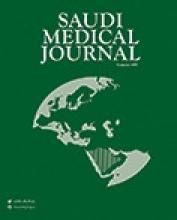Abstract
OBJECTIVE: To find out the prevalence of the central nervous system anomalies (CNS) and the outcome after surgical correction of operable defects.
METHODS: This is a retrospective review of all cases diagnosed antenatally with CNS anomalies in the Department of Obstetrics and Gynecology at King Abdulaziz University Hospital (KAUH), Jeddah, Kingdom of Saudi Arabia from January 1997 to March 2005, and their outcome including perinatal deaths and postoperative outcome following surgical correction carried out as treatment or palliative.
RESULTS: Ninety CNS anomalies were diagnosed antenatally, and 86 were confirmed postnatally. Forty-one (47.7%) were neural tube defects (NTDs) (24 were spina bifida associated with hydrocephalus, 3 encephalocele, 14 anencephaly), 36 (41.9%) were hydrocephalus, 4 (4.65%) holoprosencephaly, 3 (3.4%) microcephaly, and 2 (2.32%) with brain cysts. Of the 41 cases that were operated, 6 (14.6%) died, 26 (63.4%) survived with severe neurological sequelae, 6 (14.6%) lost follow-up, and 3 (7.3%) did well for the period of follow-up.
CONCLUSION: The prevalence of CNS anomalies is comparable to worldwide prevalence. The NTDs are important component of these anomalies, and implementation of strategies to decrease the rate of these anomalies would be beneficial to prevent them as they carry a high rate of handicap and suffering, even after surgical correction.
- Copyright: © Saudi Medical Journal
This is an open-access article distributed under the terms of the Creative Commons Attribution-Noncommercial License (CC BY-NC), which permits unrestricted use, distribution, and reproduction in any medium, provided the original work is properly cited.






